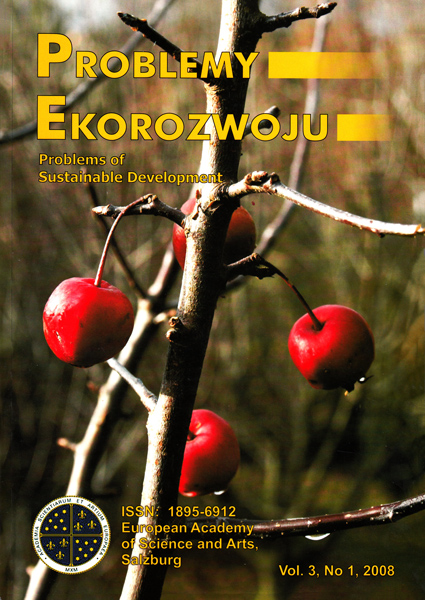Emission Reduction of Greenhouse Gases: Emission Quotas or Mandated Control Technologies
Article Sidebar
Open full text
Issue Vol. 3 No. 1 (2008)
-
Stefan Kozłowski (1928-2007): Interwoven to the Rhythm of Nature
Krystyna Bonenberg5
-
The Role of Social Sciences and Philosophy in Shaping of the Sustainable Development Concept
Artur Pawłowski7-11
-
Sustainable Capitalism: A Matter of Ethics and Morality
John Ikerd13-22
-
Emission Reduction of Greenhouse Gases: Emission Quotas or Mandated Control Technologies
Dan Golomb23-25
-
The Philosophical and Social Conditioning of Sustainable Development
Zbigniew Hull27-31
-
Dilemmas for Sustainable Development in Poland
Jacek Jaśkiewicz33-38
-
Promoting Sustainability Through Green Chemistry, Part 1
Tadeusz Paryjczak39-44
-
Promoting Sustainability Through Green Chemistry, Part 2
Tadeusz Paryjczak45-51
-
Sustainable Development in Contemporary Civilisation. Part 1: The Environment and Sustainable Development
Artur Pawłowski, Lucjan Pawłowski53-65
-
The Philosophy of Dialogue as One of the Aspects to Sustainable Development
Irena Grochowska67-72
-
The Human-Animal Relationship in its Ecological Aspect
Stanisław Jedynak73-76
-
Book Review: Democracy in Space. Criticism of the Idea of “New Civilization” Presented by Prof. H. Skolimowski in His Book “Philosophy for a New Civilization”/ Recenzja
Paweł Dybel77-80
Archives
-
Vol. 5 No. 2
2010-07-01 21
-
Vol. 5 No. 1
2010-01-04 16
-
Vol. 4 No. 2
2009-07-01 19
-
Vol. 4 No. 1
2009-01-05 22
-
Vol. 3 No. 2
2008-07-01 19
-
Vol. 3 No. 1
2008-01-02 12
-
Vol. 2 No. 2
2007-07-02 13
-
Vol. 2 No. 1
2007-01-02 11
-
Vol. 1 No. 2
2006-07-03 15
-
Vol. 1 No. 1
2006-01-02 8
Main Article Content
Authors
Abstract
It is argued that instead of imposing on each country internationally agreed quotas on Greenhouse Gas (GHG) emission reductions, it would be easier to implement, enforce and verify, if each country mandates the installation of Best Available Control Technology (BACT) for each significant industrial category. It is BACT that has to be agreed on by an international convention, such as the Intergovernmental Panel on Climate Change (IPCC). A possible BACT for coal-fueled power plants is the Integrated Coal Gasification Combined Cycle (IGCC) cum Carbon Capture and Sequestration. For transportation vehicles, there is no “add-on” technology that can capture CO2 emissions. Here CO2 emissions must be limited by increased fuel mileage. There should be an internationally agreed maximum vehicle weight for passenger cars, which the author suggests to be 1000 kg. Because BACT can be implemented only on new sources, there must be an anti-grandfathering rule, e.g. all existing coal-fired power plants must be retired after their 35th year operating time; all personal vehicles must be scrapped after their 10th year on the road.
Keywords:
References
GOLOMB D. New source performance standards for greenhouse gases, Environmental Science and Technology, 15 October 2007.
FAY J., GOLOMB D. Energy and the Environment, Oxford U. Press, 2002
Article Details
Abstract views: 64
License

This work is licensed under a Creative Commons Attribution-ShareAlike 4.0 International License.


